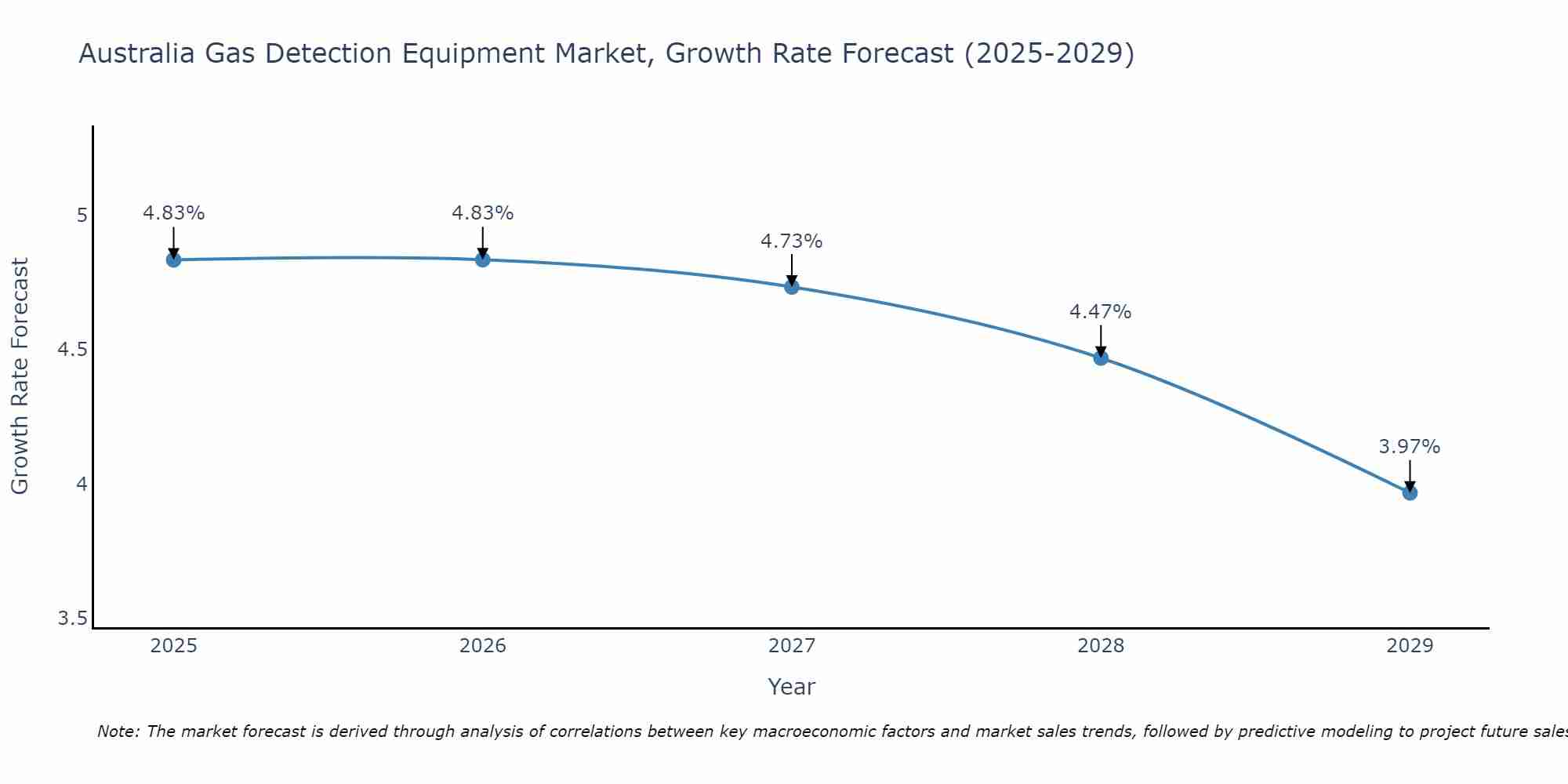Australia Gas Detection Equipment Market (2025-2031) | Analysis, Size, COVID-19 IMPACT, Share, Outlook, Revenue, Companies, Trends, Value, Growth, Forecast & Industry
| Product Code: ETC050055 | Publication Date: Jan 2021 | Updated Date: Aug 2025 | Product Type: Report | |
| Publisher: 6Wresearch | Author: Ravi Bhandari | No. of Pages: 70 | No. of Figures: 35 | No. of Tables: 5 |
Australia Gas Detection Equipment Market Size Growth Rate
The Australia Gas Detection Equipment Market is projected to witness mixed growth rate patterns during 2025 to 2029. Growth accelerates to 4.83% in 2026, following an initial rate of 4.83%, before easing to 3.97% at the end of the period.

Australia Gas Detection Equipment Market Overview
The Australia Gas Detection Equipment market involves the production, distribution, and utilization of devices designed to detect and monitor the presence of hazardous gases in various industrial, commercial, and residential settings. Gas detection equipment includes portable gas detectors, fixed gas monitoring systems, and wireless gas sensors used for safety, environmental compliance, and workplace protection. The market is driven by factors such as occupational safety regulations, industrial hygiene standards, and increasing awareness of workplace hazards. Additionally, technological advancements in sensor technology, wireless connectivity, and data analytics influence market dynamics in Australia.
Drivers of the market
The Australia gas detection equipment market is experiencing robust growth driven by the increasing focus on workplace safety, environmental monitoring, and regulatory compliance across industries such as oil & gas, mining, manufacturing, and construction. Gas detection equipment, including portable gas detectors, fixed gas monitors, and gas detection systems, play a crucial role in detecting and monitoring hazardous gases to prevent accidents and ensure worker safety. The stringent occupational health and safety regulations, growing awareness of workplace hazards, and advancements in sensor technology are driving the demand for gas detection equipment in Australia.
Challenges of the market
The gas detection equipment market in Australia faces challenges such as technological obsolescence, calibration requirements, and competition from alternative monitoring solutions. Market players must continuously innovate to develop advanced gas detection technologies, provide user-friendly and reliable equipment, and address concerns regarding sensor accuracy and maintenance to ensure effective gas monitoring and safety compliance.
Government Policy of the market
The Australia government may implement policies to regulate the gas detection equipment market to ensure workplace safety, environmental protection, and public health. Regulatory bodies such as Safe Work Australia and state and territory workplace health and safety authorities may establish guidelines for the design, installation, and maintenance of gas detection systems to prevent accidents, injuries, and fatalities related to hazardous gas exposure in industrial, commercial, and residential settings. Government policies may include mandatory equipment standards, certification requirements, and training programs for users and technicians to ensure the reliability and effectiveness of gas detection equipment. Additionally, the government may support research and development initiatives to advance sensor technologies, improve detection capabilities, and address emerging challenges in gas monitoring and management.
Key Highlights of the Report:
- Australia Gas Detection Equipment Market Outlook
- Market Size of Australia Gas Detection Equipment Market, 2024
- Forecast of Australia Gas Detection Equipment Market, 2031
- Historical Data and Forecast of Australia Gas Detection Equipment Revenues & Volume for the Period 2021-2031
- Australia Gas Detection Equipment Market Trend Evolution
- Australia Gas Detection Equipment Market Drivers and Challenges
- Australia Gas Detection Equipment Price Trends
- Australia Gas Detection Equipment Porter's Five Forces
- Australia Gas Detection Equipment Industry Life Cycle
- Historical Data and Forecast of Australia Gas Detection Equipment Market Revenues & Volume By Product for the Period 2021-2031
- Historical Data and Forecast of Australia Gas Detection Equipment Market Revenues & Volume By Fixed Gas System for the Period 2021-2031
- Historical Data and Forecast of Australia Gas Detection Equipment Market Revenues & Volume By Portable Gas System for the Period 2021-2031
- Historical Data and Forecast of Australia Gas Detection Equipment Market Revenues & Volume By Technology for the Period 2021-2031
- Historical Data and Forecast of Australia Gas Detection Equipment Market Revenues & Volume By Single-Gas Detection for the Period 2021-2031
- Historical Data and Forecast of Australia Gas Detection Equipment Market Revenues & Volume By Multi-Gas Detection for the Period 2021-2031
- Historical Data and Forecast of Australia Gas Detection Equipment Market Revenues & Volume By End-use for the Period 2021-2031
- Historical Data and Forecast of Australia Gas Detection Equipment Market Revenues & Volume By Household for the Period 2021-2031
- Historical Data and Forecast of Australia Gas Detection Equipment Market Revenues & Volume By Commercial for the Period 2021-2031
- Historical Data and Forecast of Australia Gas Detection Equipment Market Revenues & Volume By Industrial for the Period 2021-2031
- Australia Gas Detection Equipment Import Export Trade Statistics
- Market Opportunity Assessment By Product
- Market Opportunity Assessment By Technology
- Market Opportunity Assessment By End-use
- Australia Gas Detection Equipment Top Companies Market Share
- Australia Gas Detection Equipment Competitive Benchmarking By Technical and Operational Parameters
- Australia Gas Detection Equipment Company Profiles
- Australia Gas Detection Equipment Key Strategic Recommendations
Frequently Asked Questions About the Market Study (FAQs):
1 Executive Summary |
2 Introduction |
2.1 Key Highlights of the Report |
2.2 Report Description |
2.3 Market Scope & Segmentation |
2.4 Research Methodology |
2.5 Assumptions |
3 Australia Gas Detection Equipment Market Overview |
3.1 Australia Country Macro Economic Indicators |
3.2 Australia Gas Detection Equipment Market Revenues & Volume, 2021 & 2031F |
3.3 Australia Gas Detection Equipment Market - Industry Life Cycle |
3.4 Australia Gas Detection Equipment Market - Porter's Five Forces |
3.5 Australia Gas Detection Equipment Market Revenues & Volume Share, By Product, 2021 & 2031F |
3.6 Australia Gas Detection Equipment Market Revenues & Volume Share, By Technology, 2021 & 2031F |
3.7 Australia Gas Detection Equipment Market Revenues & Volume Share, By End-use, 2021 & 2031F |
4 Australia Gas Detection Equipment Market Dynamics |
4.1 Impact Analysis |
4.2 Market Drivers |
4.2.1 Stringent government regulations regarding workplace safety and emission control. |
4.2.2 Increasing awareness about the importance of gas detection equipment in various industries. |
4.2.3 Growing demand for gas detection equipment in the oil gas, mining, and chemical industries. |
4.3 Market Restraints |
4.3.1 High initial setup costs associated with gas detection equipment. |
4.3.2 Lack of skilled workforce for operating and maintaining gas detection equipment. |
4.3.3 Economic fluctuations impacting investment decisions in safety equipment. |
5 Australia Gas Detection Equipment Market Trends |
6 Australia Gas Detection Equipment Market, By Types |
6.1 Australia Gas Detection Equipment Market, By Product |
6.1.1 Overview and Analysis |
6.1.2 Australia Gas Detection Equipment Market Revenues & Volume, By Product, 2021-2031F |
6.1.3 Australia Gas Detection Equipment Market Revenues & Volume, By Fixed Gas System, 2021-2031F |
6.1.4 Australia Gas Detection Equipment Market Revenues & Volume, By Portable Gas System, 2021-2031F |
6.2 Australia Gas Detection Equipment Market, By Technology |
6.2.1 Overview and Analysis |
6.2.2 Australia Gas Detection Equipment Market Revenues & Volume, By Single-Gas Detection, 2021-2031F |
6.2.3 Australia Gas Detection Equipment Market Revenues & Volume, By Multi-Gas Detection, 2021-2031F |
6.3 Australia Gas Detection Equipment Market, By End-use |
6.3.1 Overview and Analysis |
6.3.2 Australia Gas Detection Equipment Market Revenues & Volume, By Household, 2021-2031F |
6.3.3 Australia Gas Detection Equipment Market Revenues & Volume, By Commercial, 2021-2031F |
6.3.4 Australia Gas Detection Equipment Market Revenues & Volume, By Industrial, 2021-2031F |
7 Australia Gas Detection Equipment Market Import-Export Trade Statistics |
7.1 Australia Gas Detection Equipment Market Export to Major Countries |
7.2 Australia Gas Detection Equipment Market Imports from Major Countries |
8 Australia Gas Detection Equipment Market Key Performance Indicators |
8.1 Percentage increase in the adoption of gas detection equipment across industries. |
8.2 Number of reported workplace accidents related to gas leaks or exposure. |
8.3 Rate of technological advancements in gas detection equipment. |
8.4 Percentage of companies conducting regular maintenance and calibration of gas detection equipment. |
8.5 Number of regulatory compliance checks or audits related to gas detection equipment usage. |
9 Australia Gas Detection Equipment Market - Opportunity Assessment |
9.1 Australia Gas Detection Equipment Market Opportunity Assessment, By Product, 2021 & 2031F |
9.2 Australia Gas Detection Equipment Market Opportunity Assessment, By Technology, 2021 & 2031F |
9.3 Australia Gas Detection Equipment Market Opportunity Assessment, By End-use, 2021 & 2031F |
10 Australia Gas Detection Equipment Market - Competitive Landscape |
10.1 Australia Gas Detection Equipment Market Revenue Share, By Companies, 2024 |
10.2 Australia Gas Detection Equipment Market Competitive Benchmarking, By Operating and Technical Parameters |
11 Company Profiles |
12 Recommendations |
13 Disclaimer |
- Single User License$ 1,995
- Department License$ 2,400
- Site License$ 3,120
- Global License$ 3,795
Search
Thought Leadership and Analyst Meet
Our Clients
Related Reports
- Germany Breakfast Food Market (2026-2032) | Industry, Share, Growth, Size, Companies, Value, Analysis, Revenue, Trends, Forecast & Outlook
- Australia Briquette Market (2025-2031) | Growth, Size, Revenue, Forecast, Analysis, Trends, Value, Share, Industry & Companies
- Vietnam System Integrator Market (2025-2031) | Size, Companies, Analysis, Industry, Value, Forecast, Growth, Trends, Revenue & Share
- ASEAN and Thailand Brain Health Supplements Market (2025-2031) | Strategy, Consumer Insights, Analysis, Investment Trends, Opportunities, Growth, Size, Share, Industry, Revenue, Segments, Value, Segmentation, Supply, Forecast, Restraints, Outlook, Competition, Drivers, Trends, Demand, Pricing Analysis, Competitive, Strategic Insights, Companies, Challenges
- ASEAN Bearings Market (2025-2031) | Strategy, Consumer Insights, Analysis, Investment Trends, Opportunities, Growth, Size, Share, Industry, Revenue, Segments, Value, Segmentation, Supply, Forecast, Restraints, Outlook, Competition, Drivers, Trends, Demand, Pricing Analysis, Competitive, Strategic Insights, Companies, Challenges
- Europe Flooring Market (2025-2031) | Outlook, Share, Industry, Trends, Forecast, Companies, Revenue, Size, Analysis, Growth & Value
- Saudi Arabia Manlift Market (2025-2031) | Outlook, Size, Growth, Trends, Companies, Industry, Revenue, Value, Share, Forecast & Analysis
- Uganda Excavator, Crane, and Wheel Loaders Market (2025-2031) | Strategy, Consumer Insights, Analysis, Investment Trends, Opportunities, Growth, Size, Share, Industry, Revenue, Segments, Value, Segmentation, Supply, Forecast, Restraints, Outlook, Competition, Drivers, Trends, Demand, Pricing Analysis, Competitive, Strategic Insights, Companies, Challenges
- Rwanda Excavator, Crane, and Wheel Loaders Market (2025-2031) | Strategy, Consumer Insights, Analysis, Investment Trends, Opportunities, Growth, Size, Share, Industry, Revenue, Segments, Value, Segmentation, Supply, Forecast, Restraints, Outlook, Competition, Drivers, Trends, Demand, Pricing Analysis, Competitive, Strategic Insights, Companies, Challenges
- Kenya Excavator, Crane, and Wheel Loaders Market (2025-2031) | Strategy, Consumer Insights, Analysis, Investment Trends, Opportunities, Growth, Size, Share, Industry, Revenue, Segments, Value, Segmentation, Supply, Forecast, Restraints, Outlook, Competition, Drivers, Trends, Demand, Pricing Analysis, Competitive, Strategic Insights, Companies, Challenges
Industry Events and Analyst Meet
Whitepaper
- Middle East & Africa Commercial Security Market Click here to view more.
- Middle East & Africa Fire Safety Systems & Equipment Market Click here to view more.
- GCC Drone Market Click here to view more.
- Middle East Lighting Fixture Market Click here to view more.
- GCC Physical & Perimeter Security Market Click here to view more.
6WResearch In News
- Doha a strategic location for EV manufacturing hub: IPA Qatar
- Demand for luxury TVs surging in the GCC, says Samsung
- Empowering Growth: The Thriving Journey of Bangladesh’s Cable Industry
- Demand for luxury TVs surging in the GCC, says Samsung
- Video call with a traditional healer? Once unthinkable, it’s now common in South Africa
- Intelligent Buildings To Smooth GCC’s Path To Net Zero


















